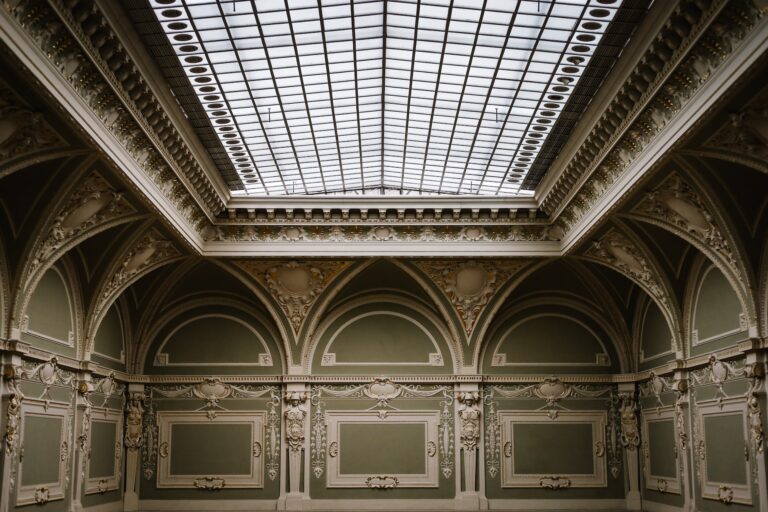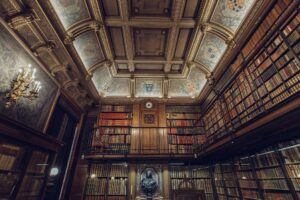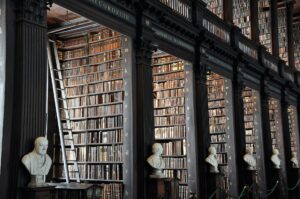Discover the Neoclassicism Meaning and Neoclassical Art Period
Introduction
The Neoclassical period was a time of great change and discovery in the world of art. It was an era that brought about masterpieces from some of the greatest artists, leaving behind a legacy for future generations to appreciate. The neoclassicism definition can be confusing at first, but with a deeper understanding comes greater appreciation. Look back into history and come to understand this movement that still influences us today. Let’s take a journey through neoclassicism and discover how it has shaped our artistic landscape.
Imagery is often used as one way to access memories or evoke emotion within a person. In regards to neoclassicism, many are reminded of grandeur coupled with beauty – intricate marble sculptures depicting gods and goddesses; classic columns and arches symbolizing strength and stability; elegant paintings capturing moments frozen in time. These images allude to something more than just mere aesthetics; they tell stories of vast civilizations past while giving hints on what lies ahead in the future.
Neoclassicism is much more than its imagery though – it is also defined by its philosophy, purpose and principles which have been passed down throughout history to become part of society’s collective memory. To fully comprehend the neoclassical period, we must open up our minds and delve into its deeper meanings so that we may gain further insight into this influential movement that continues to shape our lives even now.
Neoclassicism Meaning
Neoclassicism is a style of art and architecture, art and design that emerged in the mid-18th century. It is characterized by its reverence for classical antiquity and was inspired by ancient Greek and Roman cultures. Its influence can be seen across many disciplines, from painting to neoclassical sculpture, music to literature — and it remains an important part of our cultural heritage today. The neoclassical period began with the Age of Enlightenment in Europe during the late 1700s and lasted until around 1800 when Romanticism took over.
The defining characteristics of neoclassicism include symmetry, balance, orderliness, clarity of form and line, as well as minimal decoration or adornment. This is exemplified through neoclassical paintings featuring ordered composition with equal focus on figures and objects within the frame; sculptures that exhibit strict proportions between individual elements; buildings designed based on classical models such as temples or amphitheaters; furniture with straight lines and simple ornamentation; musical compositions which follow set structures like sonatas or symphonies; and literary works that often feature strong heroic characters modeled after Ancient Greece’s demigods.
All these aspects come together to create a distinct aesthetic: one rooted in tradition but at the same time imbued with modernity—a combination that has been embraced throughout history by great artists to everyday people alike. Neoclassicism may have faded somewhat since its heyday centuries ago, but its lasting impact continues to shape how we view beauty today.
History Of The Neoclassical Period
The Neoclassical period started in the mid to late 18th century and left a lasting impact on art history. This was an era when classical antiquity was revived, particularly Greek and Roman themes, which inspired painters all over Europe. It also saw a tremendous focus on fine art by prominent figures such as Jacques Louis David and Antonio Canova.
Neoclassicism focused on ancient Greek and Roman themes, which were seen to embody beauty, harmony, order and rationality. The movement sought to bring back these concepts through its use of naturalistic details, mythological references and linear compositions reminiscent of Classical sculptures from Ancient Greece. Many Neoclassical painters drew inspiration from archaeological discoveries during this time period, allowing them to create works that blended ancient motifs with modern elements.
Artists during the Neoclassical Movement created paintings that depicted historical events or celebrated heroic deeds of individuals who embodied their idea of what it meant to have greatness within society. One example is Jacques-Louis David’s painting “Oath of Horatii” which paints a scene where three warriors take an oath before going off to battle for Rome’s honor against Alba Longa—an event taken directly from Roman history books. Similarly, Antonio Canova produced several marble statues based on Classical figures like Cupid and Psyche or Hercules slaying the Hydra – both depicting scenes from mythology while still capturing the grandeur associated with classical antiquity.
This period brought together many different aspects of fine art in a way that had not been seen before; bridging the gap between past and present culture in order to create something entirely new yet still true to its roots. By using techniques inspired by classical forms while telling stories rooted in social issues of the day – artists during this era made sure their work would remain relevant even centuries later.
Characteristics Of Neoclassical Art
It is characterized by its use of elements from ancient Greece and Rome. It emerged in the early 18th century as a reaction against the heavily decorative Baroque style, distinguished by its noble simplicity, harmony and balance. Its development was seen across various mediums such as painting or sculpture, architecture, interior design and fashion:
- Ancient Art – emphasizes stylistic similarities with classical Greek and Roman art; it began when artists looked to rediscover the aesthetic principles of ancient Greece and Rome. This revival of antiquity often manifests itself in works that contain references to Greco-Roman sculptures.
- Geometric Balance – The neoclassical style adopts many features from ancient artworks including symmetrical composition, geometric shapes and overall balance between forms. This can be seen through neoclassical buildings which typically feature tall columns and porticos based on those used in Greek temples.
- Noble Simplicity – As opposed to the ornate Baroque period before it, neoclassicism seeks out ‘noble simplicity’ – a concept inspired by Roman authors who advocated for moderation rather than excessiveness within the artwork. This echoes throughout neoclassical sculptors’ work where they focus more on naturalism over grandeur.
- Revival Architecture – Another key aspect of neoclassical style is known as ‘revival’ architecture which exhibits traits from both Renaissance and Classical periods merged together into one building or structure that takes inspiration from past eras but applies modern techniques during construction. Throughout Europe, there are numerous examples of these neo-classicist structures built using principles derived from Ancient Greek and Roman designs adapted for contemporary purposes.
The widespread impact of this movement has been felt since its inception in many different areas not just the visual arts but also literature, theatre music etc., making it an invaluable part of our cultural heritage today. Through its timeless appeal, neoclassicism continues to inspire future generations with its synthesis of classic motifs combined with modern interpretations – something we see regularly even now within popular culture today
Neoclassical Artists
Painters, sculptors and architects of the neoclassical age made their mark with masterful works. Pioneers of this period revolutionized art with a style that pulled from antiquity and classical ideals. Prominent neoclassical artists created timeless pieces that remain admired centuries later.
Pioneering painters such as Jacques-Louis David, John Flaxman, Antonio Canova and Benjamin West all left an indelible mark on the world’s culture through their neoclassical artwork. These renowned creators crafted grandiose compositions in sharp detail to awe viewers. While each artist had their own unique take on the genre, they shared a common enthusiasm for depicting mythology and heroic figures.
An equally impressive group of sculptors graced the era with stunning three-dimensional pieces. Names like Bertel Thorvaldsen, Jean Antoine Houdon and Antonio Corradini carved out legacies by crafting exquisite sculptures of gods, goddesses and historical characters alike. Their work was lauded far and wide for its intricate details and emotive portrayals of people from days gone by.
Relationship Between Neoclassicism And Rococo Art
Neoclassicism and Rococo art have a complex relationship. These two movements are linked together, yet their fundamental characteristics drastically contrast each other. Neoclassical art emerged in the mid-18th century as an opposition to the ornate decorative art of the Rococo period. It sought to revive Greek and Roman ideals through its focus on structure and simplicity – particularly evident in neoclassical architecture, painting, sculpture and work. On the other hand, Rococo was known for its elaborate use of curves, asymmetrical designs and bright colors.
The tension between these two styles can be seen throughout the 18th century when they were both prominent art movements. While some artists worked within one or the other style exclusively, others blended elements from both into their works. This often created hybrid pieces that balanced well with the desire for classical order while also including baroque flourishes found in rococo pieces.
By understanding this dynamic balance between neoclassical art and rococo, we get a better appreciation for how it has shaped much of European culture during this time period. From
Renaissance-inspired paintings to sculptures drawing inspiration from ancient Rome – many classic works still influence us today come directly from this era’s fascination with reviving traditional values in combination with more modern sensibilities.
Relationship Between Neoclassicism And Baroque Art
Neoclassicism and Baroque art have a complex relationship. It’s rooted in the Renaissance period when works of Greek architecture were combined with Roman styles to create something new. This style was then carried on by the Baroque movement which emerged during the 1600s. While it was heavily influenced by Neoclassical ideas, Baroque art also had its own unique elements such as grandiose details, ornate decorations, and intricate patterns.
Romantic music is another area where neoclassicism and baroque art overlap. Romantic composers often used elements from both these periods in their compositions – for example, Beethoven drew inspiration from classical forms while adding touches of Baroque ornamentation to his work. This hybrid approach helped him produce some of his most beloved pieces like Symphony No 5 and Moonlight Sonata.
The relationship between neoclassicism and baroque art isn’t one-sided though; there are many ways that they’ve impacted each other over time. For instance, modern architects continue to draw upon the principles of classicism while incorporating aspects of romanticism into contemporary designs. Similarly, musicians today experiment with combining neo-classical melodies with more traditional baroque motifs to create innovative soundscapes. As both movements evolve alongside each other, their influence on our culture continues to be felt in different ways all around us.
Relationship Between Neoclassicism And Decorative Art
It is widely known that the relationship between neoclassicism and decorative art was one of great importance. From the late 18th and early 19th centuries, artists across Europe began looking back to ancient Greeks and Romans for inspiration in their works. This movement, known as neoclassicism, provided many with a way for us to become great again following the French Revolution. Many famous neoclassical painters emerged during this time such as Jacques-Louis David and Jean Auguste Dominique Ingres who were part of founding members of The Royal Academy of Art.
As well as painters, there were also leading neoclassical composers like Ludwig van Beethoven whose music embodied forms of neoclassicism. Later on, romantic artists blended classical motifs with their own ideas creating what we now call neo-romanticism but many neoclassical elements can still be found in various pieces today.
The principles behind neoclassicism art revolved around virtues such as selflessness, morality and patriotism which are seen throughout European artwork from this period. Moreover, its architecture includes large columns or pilasters along with symmetrical shapes fulfilling aesthetic goals rather than functional ones often inspired by monuments from antiquity. It’s no surprise then why it became so popular among those going on a grand tour in search of knowledge about European art history – these trips included visits to places where ancient ruins could be admired allowing them access to classic styles not commonly seen before this point in time. One famous artist of Neoclassicism is Antonio Canova who lived most of his life in Rome making him an integral part of the movement itself.
Neoclassicism left us with some beautiful creations that have stood the test of time; providing many examples from different areas such as painting, sculpture, poetry and even musical compositions which all trace back to its revivalist roots stemming from a desire for greatness after the French revolution. With its emphasis on beauty combined with moral values it has allowed us insight into how people viewed themselves and their place within society both then and now; showing us just how much our world has changed while staying rooted in tradition at the same time.
How Neoclassicism Influenced Future Art Movements
Neoclassicism was a movement that greatly impacted the development of art in Europe and beyond. It began during the mid-18th century as an artistic reaction to the excesses of Baroque and Rococo styles, with its roots firmly planted in classical antiquity. While there have been various interpretations of how this period influenced future movements, it’s clear that neoclassical elements still exist today. French painter Jacques Louis David is credited for initiating the neoclassic style through his works depicting Greco-Roman themes such as ‘The Oath of Horatii.’
One theory suggests that Neoclassicism laid the foundations for romanticism, which emerged later in the 19th century. Both sought to evoke strong feelings from viewers, but while classicists were driven by idealized forms and rational thought, romantics focused more on emotions and nature.
Additionally, some argue that impressionism can be seen as a direct descendant of neoclassicism since many painters continued to use subdued colors and sharp contrasts—a characteristic evident in much of Davids’ work.
By considering all these points together we may conclude that despite differences between each era’s ideas and techniques, they share commonalities in terms of their approach to creating meaningful artwork. As Neoclassicism evolved over time it became increasingly known for its focus on harmony, clarity, and precision – values that are still relevant today.
Furthermore, its effect could also be felt outside painting; music composition often took inspiration from ancient Greek myths or stories too leaving us no doubt about neoclassicism’s lasting legacy in subsequent eras.
Conclusion
I have discussed the definition of neoclassicism and its period. Neoclassicism is a style that emerged in the late 18th century as a reaction to Rococo art and was heavily influenced by classical antiquity. It focused on themes such as order, balance, restraint, and rationality. Examples of this type of artwork can be found throughout Europe – from paintings to neoclassical sculptures.
Romanticism was an artistic movement that opposed neoclassicism’s emphasis on reason and precision. Instead, it praised emotion and imagination. The Enlightenment also had an impact on neoclassicism with its promotion of rational thought and scientific inquiry influencing many artists who then used their newfound knowledge in their work.
Finally, modern art movements continue to draw inspiration from neoclassical works today; even though the original style has evolved over time, some aspects remain the same. This shows how influential the neoclassical period really was for future generations of artists!





